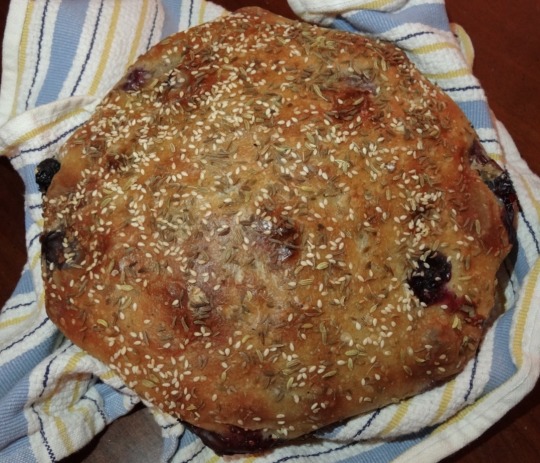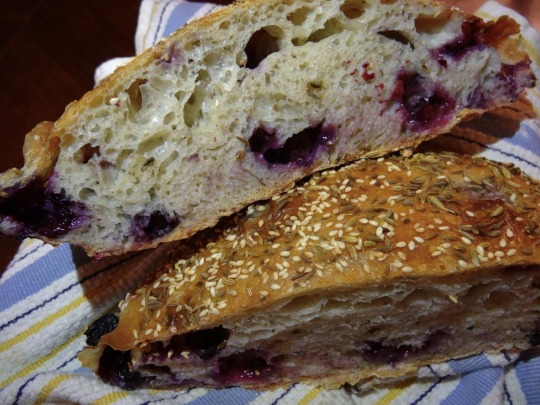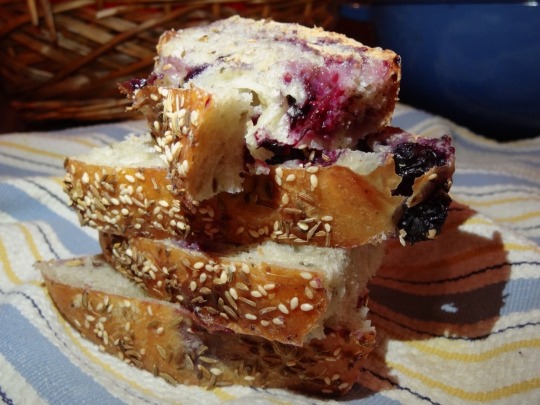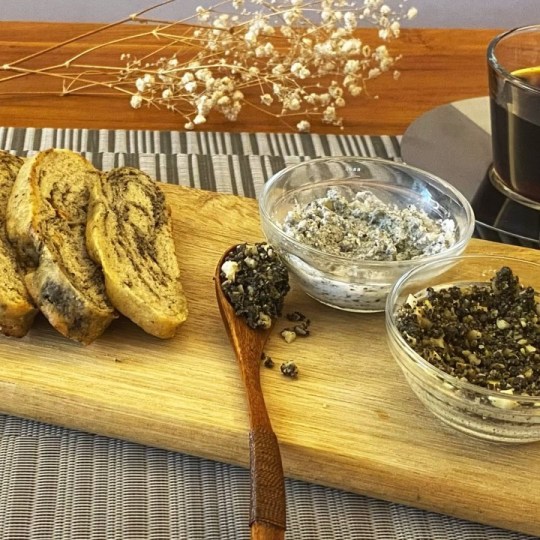#duqqa
Text
duqqa, an egyptian condiment
one time, I was watching the Great British Baking Show and a lady had some of this at her disposal: I don’t remember what she was making per se, but this just stuck out to me. It sounded amazing, so I decided to try it out myself—given what’s happening right now in the MENA region, with the specter of terror looming over Israel and the Levant and North Africa, and everyone in the western world… being as they are, I feel this need to archive traditional recipes from the region (especially Jewish and Israeli ones), away from the grip of a caliphate.
1/2 cup hazelnuts
1/4 cup pistachios
1/4 cup sesame seeds
3/4 teaspoon fennel seeds
3/4 teaspoon ground coriander
3/4 teaspoon ground cumin
1/2 teaspoon salt
Toast the hazelnuts and pistachios for 2 minutes in a dry pan, or until fragrant. Add the seeds and toast for another minute. Since there’s no butter or oil, stir to keep them from burning!
Some people use a food processor, i like to use a mortar and pestle and grind up the nuts and seeds. Add the cumin, coriander, and salt, and grind/blitz.
warning: this stuff is quite literally like cocaine. you put it on a salad or a piece of fish, you’re going to want to put it on literally everything.
1 note
·
View note
Text
Duqqa Recipe

Famous Egyptian nut, seed, and spice mixture known as duqqa or dukkah is eaten as an appetizer or as a snack with bread or raw vegetables. 1 tablespoon coriander seeds, 2 tablespoons hazelnuts, 1 cup hazelnuts, 1 tablespoon za'atar, 2 tablespoons cumin seeds, 1/3 cup sesame seeds, 1 tablespoon salt, 1/4 cup dried mint leaves
0 notes
Text


[ID: First image is of a golden brown boule studded with blueberries and covered with seeds; second image shows the boule cut in half to show a holely bread with blueberries throughout. End ID]
Rustic no-knead blueberry bread
This is a crusty, no-knead, sweet-savory bread that pairs blueberries with spices and herbs inspired by West Asian cooking. Fennel, anise, sesame, and mahlab powder are reminiscent of the دُقَّة كَعْك ("duqqa ka'k"; cake powder) used in pastries, while za'tar and caraway skew more savory.
The long rise yields a well-fermented dough with a robust flavor that stands up well against the sweetness and pungency of the fennel and aniseed. The result is a jammy, complex, aromatic boule.
This bread has an open, irregular crumb, great for slicing, toasting, dipping, or spreading. Try it with labna and honey, olive oil and za'tar, or a spreadable cheese. I've also made sandwiches with thick slices of this bread and fried, glazed tofu drizzled with tarator and topped with Iraqi mango pickles, to excellent effect.
Recipe under the cut!
Patreon | Paypal | Venmo
Makes one medium-sized boule.
Ingredients:
3 cups (360g) bread flour
2 tsp kosher salt
1/4 tsp dry active yeast
2 tsp mahlab powder (optional)
1 tsp fennel seed + 1 tsp aniseed, coarsely ground
About 1 2/3 cup water (room temperature)
1/2 cup firm fresh blueberries
1 Tbsp za’tar (wild thyme), crumbled
Additional fennel seeds, aniseed, caraway, and sesame, to top
Mahlab (محلب) powder is the ground-up pits of Mahleb cherries. It can be purchased at a halal or specialty spice store.
Za'tar (wild thyme) can be found in dried form at a halal grocery store. Note that the spice blend, which includes wild thyme, sumac, sesame seeds, and other spices, will also be labelled "za'tar." If you don't have or can't locate any of the herb itself, use any dried woody herb of your choice (e.g. rosemary, thyme, sage), chopped.
Instructions:
1. Making the dough. Measure flour into a large mixing bowl. Add salt, yeast, seeds, and thyme and stir to combine.
2. Gradually add water until a soft, sticky dough forms. You may need more or less than 1 2/3 cup.
3. Flatten dough in the bowl and top with some of the blueberries. Fold the dough to enclose the blueberries, add more blueberries on top, and fold again. Repeat until all blueberries are incorporated.
4. First rise. Shape dough into a ball and place in the bowl seam-side down. Pat the top of the dough with some olive oil and cover the bowl with a kitchen towel. Allow to rest at room temperature for 16-20 hours.
5. Shaping. Gently remove the dough from the bowl and allow it to deflate. Shape the boule by folding an edge in over the center, rotating the dough slightly, and repeating until you have gone all the way around.
6. Flip the ball over so the seam side is down. Place your hands on either side of the dough and then move them down towards the base of the boule, tucking some of the dough under and towards the seam, to tighten the top of the ball. Rotate the ball slightly and do this again, repeating until you've gone all the way around a couple times.
This is the basic method for shaping a boule, lightly adapted to avoid breaking any blueberries. If any of the blueberries start to pop out of the surface of the dough, just press them back in.
7. Second rise. Place your boule on a piece of parchment paper and cover with a kitchen towel. Allow to rise for 1-2 hours, until noticeably puffy.
8. Baking. Place a Dutch oven in your oven and preheat to 450 °F (230 °C). Remove the Dutch oven and place the boule, along with the parchment paper, inside. Put the lid on the Dutch oven and return it to the oven. Bake for 30 minutes.
9. Remove the Dutch oven's lid and bake bread for another 20 minutes, or until the crust is deeply golden brown.
To bake the bread without a Dutch oven, preheat a baking tray in the center of the oven, while preheating a skillet (rated to at least 450 °F) in the bottom; once preheated, transfer the bread and parchment paper to the tray, and pour a few cups of water in the skillet; bake for 30 minutes. Remove the skillet and bake another 20 minutes until golden brown.
Allow the bread to cool completely before cutting into it to avoid creating a mushy texture.

215 notes
·
View notes
Text


[FLAG ID: Two identical rectangular flags that are next to each other with 6 equally shaped stripes going from top to bottom. The colors in order are duqqa brown, brown bramble, hot hibiscus, jaffa orange, purple opulence, and schiava blue. / END ID]
BLACK LESBOY
[PT: Black Lesboy / END PT]
A flag for lesboys who are black!
Made by me, requested by anon.
Pinterest Archive Post
[PT: Black Lesboy. A flag for lesboys who are black. Made by me, requested by anon. Linked is a post to the Pinterest post of this flag. / END PT]
#⚧ . coining#⚧ . requests#◜🎧﹒vampblkmogai#mogai community#mogai safe#liom community#liom safe#xenogender community#black coining#black genders#black exclusive#sexuality flag#lesboy#lesboy flag#lesbian boy#pro good faith#blkmogai
18 notes
·
View notes
Text
Duqqa
Duqqa is the patron deity of the city of Car-Enfrin, the Tangelo City. Duqqa is a god of agriculture, trees and the magnificent color orange. In religious art Duqqa is depicted as a genderless figure with pale orange skin with arms turning into branches heavy with ripe oranges.
#low fantasy#conworld#worldbuilding#arkera#world building#a song of ice and fire#creative writing#conan#dark fantasy#dune#fantasy world#high fantasy#warhammer 40k#dungeons and dragons#role playing games#warhammer fantasy#sword & sorcery#game of thrones#dark souls#bloodborne#pulp fantasy#historic fantasy#cosmic horror#weird fiction#lord of the rings#world of darkness#dragon age#fullmetal alchemist#the dark tower#malazan
5 notes
·
View notes
Photo

Duqqa
Duqqa or dukkah is a famous Egyptian blend of nuts, seeds, and spices and enjoyed as a starter or snack to dip with bread or fresh veggies.
0 notes
Photo

Homemade Roasted Walnut Dukkah/Duqqa - Egyptian Spice Blend
#vegan#veganism#gluten-free#duqqa#dukkah#egyptian#spices#spice blend#spice blends#brown#cumin#peppercorns#walnuts#walnut#nuts#nut#coriander#seasoning#seasonings#sesame seeds#egyptian spice blend#condiments#condiment
19 notes
·
View notes
Photo

Lamb & Pork Kofta Platter with cilantro and pistachio duqqa, yogurt, Louisiana rice, cabbage slaw, grilled market vegetables and harissa from 1000 Figs
7 notes
·
View notes
Text
The Culinary Alphabet…A-Z…The Middle Letter Q…Duqqa...
The Culinary Alphabet…A-Z…The Middle Letter Q…Duqqa…
Welcome to series 3 of the Culinary Alphabet A-Z…Where the middle letter is Q…
So what’s in store? In this series the A, B, C, etc will be the middle letter, for example, Jarlsberg, Korma, Apple and Tursu a variety of Turkish pickled vegetables… how easy that will be who knows I am sure some of the letters of the alphabet could cause the grey matter to rebel or implode…haha…I also don’t want to…

View On WordPress
0 notes
Photo

mmmmmh nice bit of brunch @fdncoffee w/ @octophonic.audio #brunch #foundationcoffeehouse #fdncoffee #foundationwhitworth #manchester #smashedavo #smashedavocado #chorizo #halloumi #balsamicvinaigrette #duqqa #wildrocket #eggsbenedict #eggsbenny https://www.instagram.com/p/CTepA6ViQis/?utm_medium=tumblr
#brunch#foundationcoffeehouse#fdncoffee#foundationwhitworth#manchester#smashedavo#smashedavocado#chorizo#halloumi#balsamicvinaigrette#duqqa#wildrocket#eggsbenedict#eggsbenny
0 notes
Photo

#Dukkah #デュカ #Duqqa #コシャリ #Kushari #Kochari #Koshary #モロヘイヤ #mulūkhīya #ラクダ肉 #Camel #Camelus (東京都江戸東京博物館) https://www.instagram.com/p/CMEKlGUgBAo/?igshid=sr681527g7r3
0 notes
Text
Tahini Chicken Salad
Not your Bubbe’s chicken salad. Alon Shaya’s Tahini Chicken Salad takes it up a notch or ten! PassOVER! Did y’all have a lovely Passover? I rocked a homemade matzah-print headband all week, so you know I did. Anyone celebrate the end with Mimouna? How about a bagel? As you can tell, I went with a bagel. I broke into the latest cookbook in my collection, Shaya, by Chef Alon Shaya and made his…
View On WordPress
#Alon Shaya#Chicken Salad#Dukkah#Duqqa#Homemade Mayo#Mayonnaise#New Orleans#Shaya Cookbook#Tahini#Tahini Chicken Salad#Tahini Mayo
1 note
·
View note
Note
Hey Najia! I love this blog so much! I have a question. I find cooking pretty difficult sometimes. I'm chronically ill and also the kitchen stresses me out a bit because I'm very scatterbrained and there's knives and fire and stuff. I also fuck things up in the kitchen pretty easy. Are there any recipes on here you find particularly easy to make? That you'd recommend for when you just cannot be arsed? Hope you're having a wonderful day, I know it's your birthday 😄🎉
Thank you!
I can understand your stress—cooking can involve things that are objectively dangerous and also time-sensitive. I'd recommend:
Try recipes where you don't have to come into direct contact with the blades you use. Some Indian dals, for example, cook lentils in a sauce made from blended onion, tomato, and garlic; you could process them using a food processor or blender. A lot of things (fresh salsa, guacamole, a duqqa of garlic, chilies, and spices that you can throw in to cook with some lentils) can be prepared in a mortar and pestle, too.
I've never used one, but a vegetable chopper might help in a similar way that a food processor would, by reducing the amount of knifework that you have to do. There are a lot of recipes where a chopped onion is the only knifework required.
Also try recipes that are cooked in the oven, and not on the stovetop. Something that gets thrown into the oven on low heat to cook (like a casserole or fukharat dish) takes longer, but is more hands-off, than something that's cooked on the stove.
Do all of your prep work first. Read through the recipe and see what chopping, blending &c. needs to be done, prep each ingredient, and put it in its own little bowl. This includes anything in the ingredients list that says "1 onion, diced" or similar: do that right off the bat. If the recipe says "meanwhile" or asks you to do prep for anything while anything else is cooking, you might choose to disregard that and do all the prep first, depending on how long the cook time is and how much attention it needs (e.g., soup on a low simmer for half an hour can pretty much be left alone; anything in a frying pan cannot). This way you won't be rushing to chop anything quickly while worrying that something else is going to overcook.
Look for vegetables, like broccoli / cauliflower / romanesco and green beans, that can be broken up with your hands rather than chopped. Rip up cilantro and parsley rather than chopping them.
Admittedly "simple" is not the guiding principle of this blog, but here are some recipes that I think could be easily adapted:
Fukharat l3des: just one onion to chop. Cooked on low heat in the oven.
Fried tofu sandwich: just mixing sauces and spices. You can skip coating the tofu in cornstarch and frying it. Instead try freezing the whole block, thawing it, cutting into two or four pieces, and then marinating it in a plastic bag with your sauce overnight. Then bake the tofu for 15-20 minutes, turning once, at 350 °F (180 °C).
Roasted celery and potato soup: requires only very rough chopping; the cooking methods are baking and simmering. The fried tempering could be skipped by just adding those ingredients into the simmer earlier.
Carrot salad or chickpea salad or tapenade: you could throw all of the ingredients in a food processor.
Moroccan lentils: just an onion and tomato to grate or process.
Kashmiri lal chaman: the only thing you need to cut is tofu; the gravy is just water and spices. You could bake the tofu instead of frying it.
Black bean burgers: no chopping or frying if you omit the onion and carrot and elect to bake the finished patties.
'Chicken' and olive tajine: the marinade is blended or pounded, and there is no other prepwork to do other than chopping one onion. Everything can be simmered on low heat until cooked, so it's pretty hands-off.
Chana pulao: mostly rice, chickpeas, and spices. Some aromatic prep, but you could crush instead of chopping those.
Romanesco quiche: no knifework at all if you omit the aromatics and break aprt the romanesco with your hands.
Spanish garlic mushrooms: just crush garlic instead of slicing and buy pre-sliced mushrooms. There is frying, though.
Eggplant cooked salad: the eggplant is broiled and then spooned out. No knifework required if you use tomato puree.
Butternut squash soup: just roasting and simmering. No knifework required if you omit the aromatics and buy pre-cubed squash.
Dishes with a base of lentils, chickpeas, beans, rice, and/or noodles are great because there's no knifework that needs to be done to prepare the beans &c. themselves.
161 notes
·
View notes
Photo

If you haven’t tried making your own dukkah (“doo-kah) at home, read on! 💕 It only takes minutes to make this amazing all-purpose Egyptian nut, seed and spice mix and its uses are countless. 🍞 We added this black sesame dukkah into bread dough to add a nutty aroma and beautiful colour. We also stirred it into ricotta to make a delicious dip. Use it on fish or meat, sprinkle over salad, stir it into hummus, or simply, enjoy it with crusty bread and olive oil. Often made with sesame seeds, cumin and coriander – there are multiple variations and plenty of room to create your own version. Check out the link in our profile for this recipe. We hope you’ll enjoy it as much as we do! . . . . . . #dukkah #duqqa #nutsandseeds #dips #homecooks #foodie #foodiesofinstagram #cooksofinstagram #cooking #cookingathome #cookingvideo #thefeedfeed #thefeedfeedvegan #thefeedfeedglutenfree #thekitchn #vegan #veganfood #veganrecipes #glutenfree #bakersofinstagram #breadstagram #homechef #healthyrecipes #superfoods #yummy #delish #easyrecipes #easyrecipe #homemadefood #f52grams (at Egypt) https://www.instagram.com/p/CDOp9CnF59m/?igshid=16lo2n1bcj8wa
#dukkah#duqqa#nutsandseeds#dips#homecooks#foodie#foodiesofinstagram#cooksofinstagram#cooking#cookingathome#cookingvideo#thefeedfeed#thefeedfeedvegan#thefeedfeedglutenfree#thekitchn#vegan#veganfood#veganrecipes#glutenfree#bakersofinstagram#breadstagram#homechef#healthyrecipes#superfoods#yummy#delish#easyrecipes#easyrecipe#homemadefood#f52grams
1 note
·
View note
Text
Car-Enfrin
Known as “the Tangelo City” in the Caraxi tongue, this city is one of the five Caraxi city-states. The city is made up entirely of a bright reddish-orange stone that is thought to be native to the quarries outside the city. Economically the city is heavily invested in the farming and export of citrus fruits including oranges, tangelos, pomelos, limes and numerous others that are unique hybrids. The city also produces curative juices and liquor made from their citrus crop.
The city is famous for its ball-shaped buildings, many appearing as large towers of stone balls stacked on top of one another. Numerous bridges and causeways connect the high buildings at all levels with people moving about at all hours of the day. The center of the city is dominated by the temple of Duqqa, the chief god of the city. Appearing as a large glass ball on a stone base the temple amplifies a chorus of singers calling people to prayer, celebration and mourning.
#low fantasy#conworld#worldbuilding#arkera#world building#a song of ice and fire#creative writing#conan#dark fantasy#dune#fantasy world#high fantasy#warhammer 40k#dungeons and dragons#role playing games#warhammer fantasy#sword & sorcery#game of thrones#dark souls#bloodborne#pulp fantasy#historic fantasy#weird fiction#cosmic horror#dragon age#fullmetal alchemist#the dark tower#malazan#lord of the rings#world of darkness
6 notes
·
View notes
